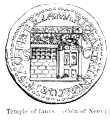Ianus
and
Iana. Two ancient Latin divinities, who were worshipped as the sun
and moon. The names Ianus and Iana were thought to be other forms of Dianus and Diana (Varro,
R. R. i. 37, 3; Macrob. i. 9), which words contain the same root as
dies, day. The ancients, however, also connected the words with
ianua, a door, which itself contains the root of
ire,
“to go.” Ianus occupied an important place in the Roman religion. He
presided over the beginning of everything, and was therefore always invoked
first in every undertaking, even before Iupiter. He opened the year and the seasons, and hence
the first month of the year was called after him (
mensis Iani, Ovid,
Fasti, ii. 51). He was the porter of heaven, and therefore bore the surnames
Patulcus or Patulcius (
pateo), “the opener,” and
Clusius or Clusivius (
cludo), “the shutter” (Ovid,
Fasti, 130). On earth, also, he was the guardian deity of gates, and hence is
commonly represented with two heads, because every door looks two ways (
Ianus
bifrons). He is sometimes represented with four heads (
Ianus
quadrifrons), because he presided over the four seasons. At Rome, Numa is said to have
dedicated to Ianus the covered passage bearing his name, which is commonly, but erroneously,
called a temple. It stood close by the Forum. A temple to Ianus was
 |
|
Temple of Ianus. (Coin of Nero.)
|
built by Duilius, to take the place of this passage; and was restored by Augustus.
It appears to have been left open in war to indicate symbolically that the god had gone out to
assist the Roman warriors, and to have been shut in time of peace that the god, the safeguard
of the city, might not escape. The gates of Ianus were closed only three times from Numa to
Augustus, and twice by Augustus. On New-year's day, which was the principal festival of the
god, people gave presents to one another, consisting of sweetmeats and copper coins, showing
on one side the double head of Ianus (see illustration under
Bifrons) and on the other a ship. The general name for these presents was
strenae, the modern French étrennes.
The connection of Ianus with the year was indicated by representing him with three fingers
of his right hand bent so as to suggest the numeral CCC [300], while the fingers of the left
hand were spread for the numerals L+V [55], and in later times L+V+V+V [65], for the 355 days
of the old Roman year and 365 of the Julian year (Pliny ,
Pliny
H. N. xxxiv. 7).





